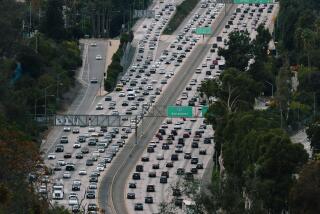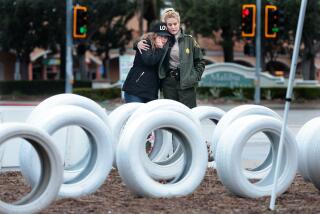Accidents Rise in Car-Pool Lane’s 1st Week : Caltrans Also Reports Commuting Times Slashed for All Motorists
- Share via
An increase in accidents accompanied higher driving speeds during the first week that the Costa Mesa Freeway’s new car-pool lane was available to motorists, transportation officials said Monday.
And between 34% and 40% of the car pools previously observed using the Costa Mesa Freeway have not moved into the new express lane, according to a study by the California Department of Transportation (Caltrans).
The California Highway Patrol reported that the number of daily accidents on the 11-mile stretch of freeway between the Riverside Freeway (Route 91) and the San Diego Freeway (Interstate 405) increased steadily all last week, reaching a high of eight on Thursday, officials said.
Dave Roper, Caltrans regional director, told the Orange County Transportation Commission on Monday that his agency is investigating the accidents to see if his agency needs to change the operation of the new express lane, which was opened to traffic last week.
Commission spokesman Tom Fortune said some of the accidents were related to increased travel speeds made possible by the new lane. “People are going faster than they’re used to, and they hit a pocket of congestion and don’t slow down fast enough, and they’re rear-ending other cars.”
The car-pool lane is restricted to vehicles carrying two or more people. The lane was added to the three existing lanes on each side of the freeway. Average travel times in the 11-mile corridor on the existing lanes were reduced from a high of 35 minutes or more before the new lane was opened to 18 minutes during the first week after it opened, officials said.
In comparison, commuters using the new car-pool lane instead of the old lanes were averaging 11-minute travel times on the 11-mile stretch.
He said only three of last week’s accidents actually involved the new lane. He said he did not know if they were speed-related or caused by other factors such as unsafe lane changes.
Roper warned commissioners that the speedup of traffic on the three old lanes would not last because more people will be attracted to the freeway.
Use of the new car-pool lane will increase, he said, because there will be a sharper difference in travel times between the new lane and the old ones.
A Caltrans survey indicated that commuter lane vehicles carried an average of 2.1 people in the morning rush and 2.27 people during the evening peak period.
Fortune said the fact that many vehicles with more than one occupant are not traveling in the commuter lane is probably because people using the freeway for short trips don’t think they have time to cross all lanes of traffic to get into and out of the car-pool lane before they reach their off-ramp.
“Also, there are probably some people who are not tuned in to what’s going on,” he said.
Caltrans also reported that between 4.7% and 9.3% of the vehicles using the car-pool lane last week were in violation of the rule requiring two or more occupants, depending upon the day and time involved.
A new study next month is expected to show how many drivers are violating the restrictions on lane changes, which are permitted at only three places in each direction along the express lane’s 11-mile span.
More to Read
Sign up for Essential California
The most important California stories and recommendations in your inbox every morning.
You may occasionally receive promotional content from the Los Angeles Times.










